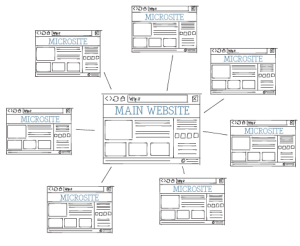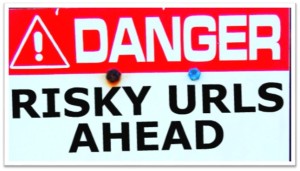Vanity URL Best Practices For Marketing Campaigns
Vanity URL Best Practices That Work
OUTATIME – A license plate or vanity URL best practice?

The DeLorean’s famous license plate from the Back to the Future trilogy is perhaps the most well-known of its kind.
The DeLorean’s famous license plate from the Back to the Future trilogy is perhaps the most well-known of its kind, slightly edging out Cameron’s NRVOUS plate from Ferris Bueller’s Day Off. I remember being fascinated by OUTATIME as a kid, so fascinated that 30-something years later I still remember it almost as fondly as I do the flux capacitor.
I tell this story because just like vanity license plates, vanity URLs are unique and memorable. If you’re looking for a more detailed vanity URL definition, you can think of them as branded web addresses created for marketing initiatives to promote a particular product, service, or idea. They’re typically redirected to a standalone microsite or landing page via easy to implement Redirect Campaigns.
For example:
- The vanity URL on a Beer Pong direct mail piece: BeerPongParty.com
- The real URL for our Beer Pong microsite: pages.boingnet/beerpong
While they won’t let you go back in time to fix all of your past marketing mistakes, implementing vanity URL best practices can go a long way towards ensuring future marketing successes. In fact, a vanity URL can increase a marketing campaign’s success rate by up to 35%.
[Tweet “A vanity URL can increase a marketing campaign’s success rate by up to 35%.”]
Still not sure if you should use vanity URL best practices for your marketing campaign? Here are five reasons why we think you should implement vanity URL best practices:
1. Vanity URLs help you Gain Online Insights from Offline Campaigns
As I mentioned in an earlier blog, offline marketing (direct mail, print ads, radio, etc.) is still very much alive and well, and a fundamental component of many of today’s multi-touch integrated campaigns. Many marketers, however, still hesitate to invest in offline initiatives because they’re not sure how to track effectiveness and ROI.
Vanity URLs turn traditional offline campaigns into trackable, actionable, lead generating machines. And while they won’t tell you who went where and who did what, if you add an incentive that drives your audience to a microsite or landing page, you can use it help you start capturing data, tracking behavior, and building your email list.
With the right software, you can even setup a personalized URL or pURL. A pURL adds an extra layer of personalization to your marketing campaign (think JoeSmith.Hamburgers.com vs. Hamburgers.com), letting you know exactly who visited your microsite and everything they did while there. There’s even some great marketing automation software on the market (ahem) that lets you set up individual drip marketing campaigns based on actions that users take when they visit a pURL printed on a piece of collateral.
2. Vanity URLs Help You Go-to-Market Faster
Believe it or not, things like style guidelines and corporate branding books exist for a very good reason. And no, that reason is not just to slow everyone down.
Pre-established guidelines provide a clear set of rules for how online and offline marketing materials should look and feel; they make sure that every visual element a company produces is consistent.
But in today’s new reality, where marketing is being asked to do more with less (and to get it all done 3 weeks ago), there’s a lot more pressure on us to deliver a much larger volume of marketing materials, including landing pages, microsites, etc. This pressure can quickly boil over if/when a time-sensitive asset is held up by a branding leader (or even worse an entire committee) who wants to make sure your design is falling in line.
When you implement a campaign on a vanity URL, however, you can often avoid these committees altogether. Because your URL is living and operating outside of your parent domain, and away from your stylized corporate homepage, you typically won’t have to get your corporate marketing or branding teams involved at all. This provides a lot more leeway for your design, cuts down drastically on your time to market, and frees up more time for you to focus on the campaign at hand.
Search, Buy & Manage Vanity URLs In Boingnet
Integrated Landing Pages, Microsites & Automation
3. Create a Vanity URL, Stay Away from IT
When you build a standalone microsite on a third party platform, whether it’s on a robust behemoth like Hubspot or a Lightweight utility tool like Boingnet, you have to determine your URL structure when the campaign goes live. You have a few choices. But if you want your microsite or landing page to point to a subdomain or subdirectory of your company’s parent domain, you’re going to need to get IT involved.
When a microsite or landing page is tied to your root domain, you can expect to have some lengthy conversations with IT about your unreasonable timelines or their preferences for subdomains vs. subdirectories. It’s just the way it goes. IT and Marketing are the Hatfield and McCoys of interdepartmental relationships. We have different objectives, different concerns, and a different understanding of each other’s jobs. This disconnect can bury a time-senstive project under piles of support tickets, unnecessarily long email threads, conference calls, and meetings
Or, you could cut IT entirely out of the equation (they will thank you for this) by redirecting a vanity URL to the URL generated by your marketing software. Most of the time this is easy enough for you to do on your own through your domain registrar and marketing tool. But if you are working with a third party agency or services partner, they can always do it for you as well.
4. Vanity URLs Keep Your Audience Focused On Your Message

Standalone microsites and landing pages with vanity URLs let you engage with users in a focused setting without any outside distractions.
The purpose of microsites and landing pages are to add focus to the digital user experience, to make it easy for visitors to quickly find and do what you want them to find and do. That’s why standalone microsites and landing pages with vanity URLs are so great — they allow you to engage and interact with users in a focused setting without any outside distractions to derail the conversation.
When you tie a campaign like this to your primary brand site, however, you’re opening up a number of potential opportunities for users to do anything other than what you want them to do. There’s a chance they could get lost or distracted by all the great content you’re offering on other pages. Before the prospect knows it, they’re checking out your blog and perusing your offerings before somehow ending up on the careers section of your site wondering why and how they landed there in the first place.
5. Track The Success of The Campaign, Not The Brand
As I mentioned earlier, today’s marketer needs to demonstrate ROI when investing in any campaign. And since almost all SMBs are marketing on a tight budget, it’s critical for them to understand exactly what is producing value and what isn’t.
Campaigns that drive to a microsite or landing page vanity URL take your audience directly where you want them to go, instead of taking them to a corporate home page with multiple messages. Not only does this help keep your messaging focused so the audience hears what you want them to hear, but it also makes sure that all the traffic, data, and conversions that come from the campaign can be tied back to your particular program instead of your parent brand. It is much easier to measure exactly how many visitors you have, what those visitors did and didn’t do when your traffic is being directed to a campaign specific vanity URL.
Use These Vanity URL Best Practices Now – Get a 60 Day Boingnet Free Trial!
Start 60 Day Free Trial
Vanity URL Best Practice Tips

Carefully choose which words you use in a vanity url. Complex words, uncommon words, or unusual spellings can derail the effectiveness of your campaign without it ever having a chance.
We’re often asked to give our opinion on what is the best way to structure a URL for a microsite or landing page. Here are five vanity URL best practices to consider before choosing a vanity URL for your marketing campaign.
- Keep it simple: Stick to a two or three word phrase – The longer your domain name, the more likely someone will forget the address or make a mistake. Also, don’t choose a URL that requires spell check to get it right. Complex words, uncommon words, or unusual spellings can derail the effectiveness of your campaign without it ever having a chance. Hint: words with “ie” or “ei” are the most commonly misspelled words.
- Avoid Slashes: While some might suggest you go with a com/vanity structure, we at Boingnet believe that vanity.com is the most effective way to do it. It’s a more foolproof approach, especially since (in our experience) users simply do not want to type anything after typing “.com”. Not only do they often forget exactly what comes after the slash, oftentimes they’re just too lazy to do it (myself included) and would prefer just go to your home page and find your campaign from there.
- Avoid Dashes between each word: Choose a domain that represents your company, product, or service in a succinct, branded fashion without dashes. People used to create domains with dashes in the past to insert exact keyword phrases and boost SEO. But that sneaky little doesn’t work anymore since Google’s EMD Update for “Exact Match Domain” update, which changed the Google algorithm to prevent any benefit received from keyword stuffing URLs.
- Capitalize every word: Always make sure you capitalize the first letter of every word in your URL when you promote it in print or online (example: JoesArtisanJellies.com). For example, do you want your URL to look like molestationnursery.com or www.MoleStationNursery.com Which reads better to you?
- Don’t add www to the URL for any type of offline activity. As a rule, you should always try to limit the amount of keystrokes you ask a user to make. This leaves less room for error, which results in greater user engagement and higher conversion rates.




